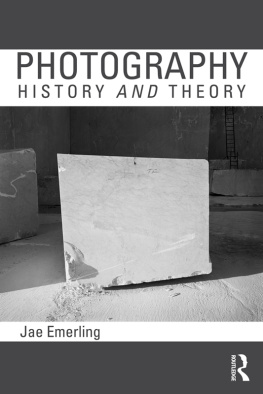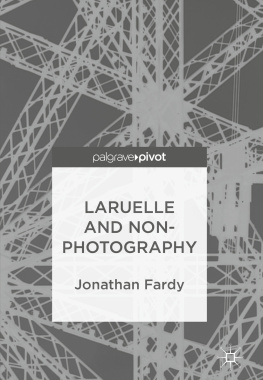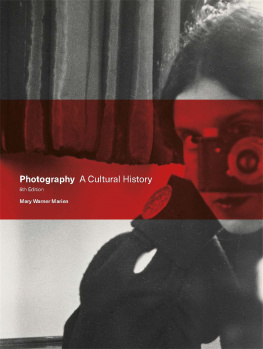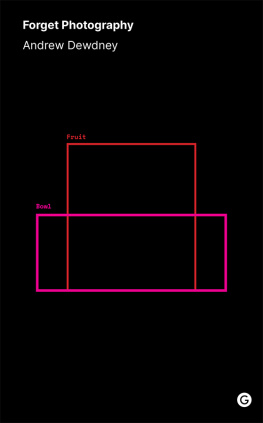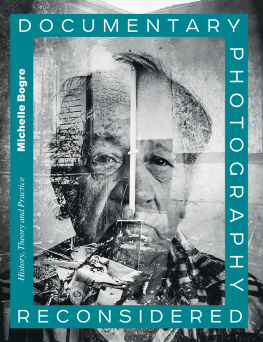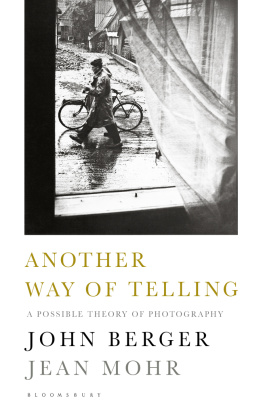Emerling - Photography: History and Theory
Here you can read online Emerling - Photography: History and Theory full text of the book (entire story) in english for free. Download pdf and epub, get meaning, cover and reviews about this ebook. City: London, year: 2012, publisher: Routledge, genre: Romance novel. Description of the work, (preface) as well as reviews are available. Best literature library LitArk.com created for fans of good reading and offers a wide selection of genres:
Romance novel
Science fiction
Adventure
Detective
Science
History
Home and family
Prose
Art
Politics
Computer
Non-fiction
Religion
Business
Children
Humor
Choose a favorite category and find really read worthwhile books. Enjoy immersion in the world of imagination, feel the emotions of the characters or learn something new for yourself, make an fascinating discovery.
- Book:Photography: History and Theory
- Author:
- Publisher:Routledge
- Genre:
- Year:2012
- City:London
- Rating:4 / 5
- Favourites:Add to favourites
- Your mark:
- 80
- 1
- 2
- 3
- 4
- 5
Photography: History and Theory: summary, description and annotation
We offer to read an annotation, description, summary or preface (depends on what the author of the book "Photography: History and Theory" wrote himself). If you haven't found the necessary information about the book — write in the comments, we will try to find it.
Photography: History and Theory — read online for free the complete book (whole text) full work
Below is the text of the book, divided by pages. System saving the place of the last page read, allows you to conveniently read the book "Photography: History and Theory" online for free, without having to search again every time where you left off. Put a bookmark, and you can go to the page where you finished reading at any time.
Font size:
Interval:
Bookmark:
Photography
Jae Emerling has done the near impossible: he has written an introduction to the history and theory of photography that also adds significantly to the ways in which we come to see, know, and understand the world. Here, by focusing on the and between history and theory, photography itself becomes ingeniously a form of thinking. Photography is history, is theory, is technology, is archive, is document, is truth, is time, is knowledge, is a way to generate new worlds politically and aesthetically. Emerling writes that to study the history and theory of photography is to write and create alongsideand in the middle ofimages. He couldnt be more right.
Marquard Smith, Director, Institute for Modern and Contemporary Culture, University of Westminster, UK
Jae Emerling has produced a timely and thoroughly useful book that shows how the history of photography and the theories encouraged by that history have shaped our experience of the photographic work of art. His writing eloquently and accessibly considers those debates that have led to the concepts through which contemporary practitioners and viewers alike now confront the impossible object of an art photograph. This book is a must for anyone serious about the production, appreciation, or use of photographic images in the twenty-first century. Emerlings work beautifully defines artistic practice and theory as complementary but not identical, and points out that images are always already ensembles of history and ideas. For as he so succinctly states in his introduction, The footprint of a bird is not a bird.
William Wylie, Professor of Art, University of Virginia, USA
Photography: History and theory offers the most complex limit case for understanding representation in our time. What Emerling has done in situating the discourse of art photography on the dual thresholds of aesthetics/ethics and theory/history, is to open up the field to the ontological complexity of its subject domain. This book is an aston-ishing performance, a nuanced and lucid argument addressed to all those interested in why photography matters today.
Claire Farago, Professor of Art History, University of Colorado at Boulder, USA
From its inception in the nineteenth century, photography has instigated a series of theoretical debates. In this new text, Jae Emerling therefore argues that the most insightful way to approach the histories of photography is to address simultaneously the key events of photographic history alongside the theoretical discourse that accompanied them.
While the nineteenth century is discussed, the central focus of the text is on modern and contemporary photographic theory. Particular attention is paid to key thinkers, such as Baudelaire, Barthes, and Sontag. In addition, the centrality of photography to contemporary art practice is addressed through the theoretical work of Allan Sekula, John Tagg, Rosalind Krauss, and Vilm Flusser. The text also includes readings of many canonical photographers and exhibitions, including Eugne Atget, Brassa, August Sander, Walker Evans, The Family of Man, Diane Arbus, Lee Friedlander, Cindy Sherman, Bernd and Hilla Becher, Sebastio Salgado, Jeff Wall, and others.
In addition, Emerling provides close readings of key passages from some major theoretical texts. These glosses come between the chapters and serve as a conceptual line that connects them.
Glosses include:
- Roland Barthes, The Rhetoric of the Image (1964)
- Susan Sontag, Regarding the Pain of Others (2002)
- Michel Foucault, The Archaeology of Knowledge (1969)
- Walter Benjamin, Little History of Photography (1931)
- Vilm Flusser, Towards a Philosophy of Photography (1983)
A substantial glossary of critical terms and names, as well as an extensive bibliography, make this the ideal book for courses on the history and theory of photography.
Jae Emerling is Assistant Professor of modern and contemporary art at the University of North Carolina, Charlotte, USA. He is the author of Theory for Art History (Routledge 2005).
Photography
History and theory
Jae Emerling

First published 2012
by Routledge
2 Park Square, Milton Park, Abingdon, Oxon OX14 4RN
Simultaneously published in the USA and Canada
by Routledge
711 Third Avenue, New York, NY 10017
Routledge is an imprint of the Taylor & Francis Group, an informa business
2012 Jae Emerling
The right of Jae Emerling to be identified as author of this work has been asserted by him in accordance with sections 77 and 78 of the Copyright, Designs and Patents Act 1988.
All rights reserved. No part of this book may be reprinted or reproduced or utilised in any form or by any electronic, mechanical, or other means, now known or hereafter invented, including photocopying and recording, or in any information storage or retrieval system, without permission in writing from the publishers.
Trademark notice: Product or corporate names may be trademarks or registered trademarks, and are used only for identification and explanation without intent to infringe.
British Library Cataloguing in Publication Data
A catalogue record for this book is available from the British Library
Library of Congress Cataloging in Publication Data Emerling, Jae.
Photography : history and theory / Jae Emerling.
p. cm.
Includes bibliographical references and index.
1. Photographic criticism. 2. Photography, Artistic--History.
I. Title.
TR187.E44 2012
770.1--dc23
2011023346
ISBN: 978-0-415-77854-1 (hbk)
ISBN: 978-0-415-77855-8 (pbk)
ISBN: 978-0-203-15321-5 (ebk)
Photography is like the art of another planet.
Henri Focillon, The Life of Forms
the world of images has never been constituted to the sole end of behaving to properly facilitate the self-constitution of a history or a knowledge.
Georges Didi-Huberman, Confronting Images
It is through admiration that you will come to genuine critique.
Gilles Deleuze, On Nietzsche and The Image of Thought
Contents
Gloss on Walter Benjamin, Little History of Photography (1931)
Gloss on Roland Barthes, The Rhetoric of the Image (1964)
Gloss on Susan Sontag, Regarding the Pain of Others (2002)
Gloss on Michel Foucault, The Archaeology of Knowledge (1969)
Gloss on Vilm Flusser, Towards a Philosophy of Photography (1983)
Figures
Courtesy of the Gernsheim Collection, Harry Ransom Humanities Research Center, The University of Texas at Austin
Courtesy of Akademie der Knste, Berlin, Bertolt-Brecht-Archiv, BBA FA 7/26
Courtesy of the National Media Museum/SSPL
Victoria and Albert Museum, London
Albert Renger-Patzsch Archiv/Ann und Jrgen Wilde, Zlpich/VG Bildkunst, Bonn/DACS, London 2010
Hattula Moholy-Nagy/DACS 2011
Walker Evans Archive, The Metropolitan Museum of Art
Courtesy of the Jersey Heritage Collections
Salvador Dali, Fundaci Gala-Salvador Dal, DACS, 2010
Jan Dibbets. Courtesy of Gladstone Gallery, New York and Tate, London 2011
ESTATE BRASSA - RMN. Courtesy of Paris, Muse National dArt Moderne Centre Georges Pompidou
Estate of Margaret Bourke-White via Getty Images
Walker Evans Archive, The Metropolitan Museum of Art, Ford Motor Company Collection, Gift of Ford Motor Company and John C. Waddell, 1987
Courtesy of the artist
Courtesy of Library of Congress, Prints & Photographs Division
Courtesy of the photographic archives at the Auschwitz-Birkenau State Museum
Next pageFont size:
Interval:
Bookmark:
Similar books «Photography: History and Theory»
Look at similar books to Photography: History and Theory. We have selected literature similar in name and meaning in the hope of providing readers with more options to find new, interesting, not yet read works.
Discussion, reviews of the book Photography: History and Theory and just readers' own opinions. Leave your comments, write what you think about the work, its meaning or the main characters. Specify what exactly you liked and what you didn't like, and why you think so.

